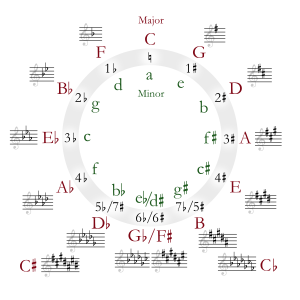|
A-sharp minor
A-sharp minor is a minor musical scale based on A♯, consisting of the pitches A♯, B♯, C♯, D♯, E♯, F♯, and G♯. Its key signature has seven sharps.[1] Its relative major is C-sharp major (or enharmonically D-flat major). Its parallel major, A-sharp major, is usually replaced by B-flat major, since A-sharp major's three double-sharps make it impractical to use. The enharmonic equivalent of A-sharp minor is B-flat minor,[1] which only contains five flats and is often preferable to use. The A-sharp natural minor scale is: Changes needed for the melodic and harmonic versions of the scale are written in with accidentals as necessary. The A-sharp harmonic minor and melodic minor scales are: In Christian Heinrich Rinck's 30 Preludes and Exercises in all major and minor keys, Op. 67, the 16th Prelude and Exercise and Max Reger's On the Theory of Modulation on pp. 46~50 are in A-sharp minor.[2] In Bach's Prelude and Fugue in C-sharp major, BWV 848, a brief section near the beginning of the piece modulates to A-sharp minor. Scale degree chordsThe scale degree chords of A-sharp minor are:
ReferencesExternal links |
||||||||||||||




